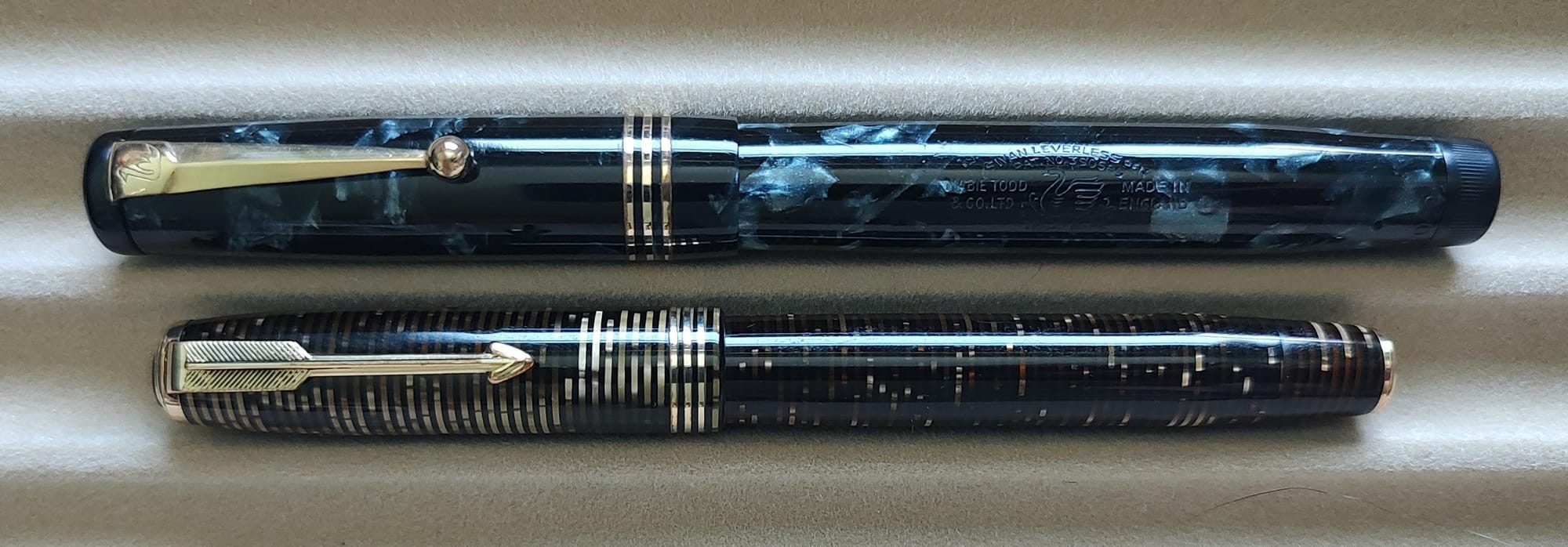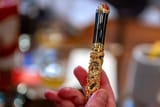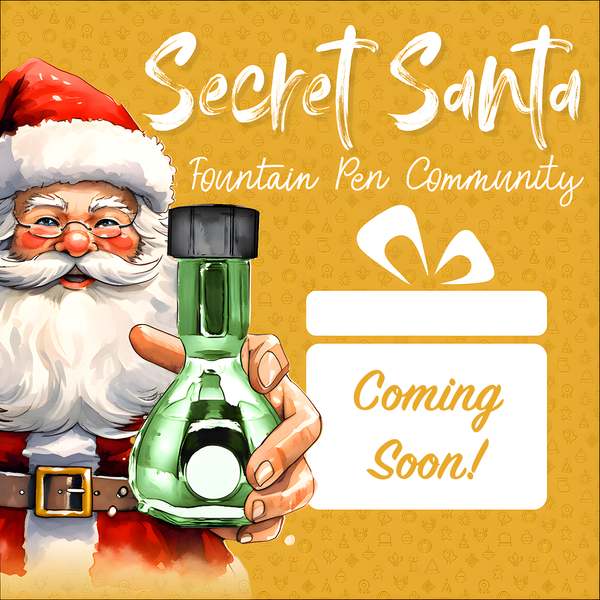Buying your first vintage fountain pen
Are you daunted by the dazzling variety of vintage pens and don't know where to start? Keep reading!

Many people feel that getting into vintage fountain pens is daunting. It doesn't have to be. You don't have to miss out on the unique writing experience of a vintage fountain pen, because in this guide I will show you how to buy your very first vintage pen!
Which pens are considered vintage?
You may get slightly different answers depending on who you ask. For me personally, vintage pens are ones made before 1980, while pens made before 1940 could be considered antique. But of course, these terms are subjective and each collector or seller may see it somewhat differently.
As a general rule of thumb, pens in a range of 50 to 100 years old are considered vintage, and pens that are over 100 years old are considered antique. You may also hear the term semi-vintage, which applies to discontinued pens which are 25 to 50 years old. Pens in this age range whose models are still in production are usually not considered semi-vintage.
Two characteristics that set vintage and antique pens apart from modern pens are that they often use materials and filling systems which are not commonly used in modern pens. Materials seen in vintage pens which are no longer commonly used include hard rubber (also known as ebonite), celluloid, and casein. As far as filling systems, use of cartridges or converters in vintage pens is rare before the 1960s, and instead you will often see filling systems such as aerometric, vacumatic, lever filler, button filler, touchdown, or other sac-based filling systems.
Why choose vintage?
History. Antique and vintage fountain pens are a way for you to connect to the time when handwriting was a part of everyday life. This allows you to channel writers of that era and share in the way that they experienced writing.
Unique feel of writing. The unique feel of an antique or vintage nib on paper is difficult to describe. It can be completely different from the feel of modern mass-produced nibs. If you're interested in flex nibs, vintage flex nibs can provide you with an absolute joy of writing without railroading, a feeling that cannot be easily replicated with a modern nib. Even if you're not interested in flex, the nibs that have survived from that era are the best-made exemplars of the era, and were manufactured and tuned to much higher standards than are commonly seen in modern pens.
Design. Whether it is a timeless design—like Parker 51 or Sheaffer Balance, that to this day is being copied by many manufacturers—or a unique design, like the Wahl-Eversharp Skyline or Parker Vacumatic—you will have a beautiful pen to look at.
Conversation piece. A vintage pen draws people to you. When you write with your pen, curious people will ask you questions, giving you a chance to share your interest and show off your special pen!

Set your budget
Like with everything else in life, it is important to set limits. Keep in mind that the price of your pen will depend on factors such as rarity, size, and condition. And luxury pens may use more valuable materials and thus cost more than the more common workhorse pens.
Everyday-writer or workhorse pens come at a variety of price points. A few examples:
- Esterbrook J steel-nib pens cost from US$30 to $60.
- Parker 51 with a gold nib will cost $120 to $240, with steel nib 51s ranging from $50 to $90.
- Parker Duofold Big Red or Sheaffer PFM will cost around $500.
In contrast, a luxury pen like a Waterman with gold or silver overlay would cost you about $1000.
Set your budget according to your financial situation and the kind of pen you're looking for.
Choose your nib size
Choose the nib size that you prefer to write with. Finding your preferred nib size could be challenging, but there are vintage pen brands that have a range of nibs widely available. One easy-to-find pen model that has a huge variety of steel nibs is Esterbrook J series. In fact, these pens are a perfect first vintage pen: it is inexpensive, and Esterbrook was the first pen maker to introduce a removable nib unit, making them easier to clean!

If you prefer to go for a gold nib, then a pen that is easy to find is the Parker 51. The design of these pens is being copied to this day.

A note about filling systems
Just as with modern fountain pens, vintage pens come with various different filling systems. I will go over the different filling systems in vintage pens in a later post. One thing I will mention is that cleaning a vintage vacuum-filling pen is very tedious.
Pen material
Pens manufactured before the mid-1930s are usually made from hard rubber, commonly known by the genericized brand name ebonite. Ebonite pens were originally only made in black. Some manufacturers added silver or gold overlays to make pens look more luxurious. The first manufacturer to introduce color to ebonite was Parker in a variant of the Duofold, and this red ebonite pen is now affectionately called Big Red.

Starting in the mid-1930s, manufacturers introduced pens made from celluloid. This is a beautiful material that was later found to be extremely flammable, and this material now illegal to manufacture in most countries.

In the 1940s, pen manufacturers started to use acrylics such as lucite or plexiglass, as well as other materials.
Where to buy
Pen show
This is the best option. Not only can you hold the pen in your hand and try writing with it, you also have the opportunity to talk with the seller face-to-face and ask as many questions as you need. And you can be sure that the pen you buy from them is in excellent restored condition.
Online from an auction
When buying from an auction site like eBay, make sure to carefully examine all of the photos and read the description. Don't be afraid to ask the seller questions or request additional photos of the pen. The description should describe the condition of the pen and photos should show it. If you aren't sure about something, ask more questions!
Online from a professional restorer or repairer
Some pen restorers have YouTube channels. Two examples are Doug Rathbun (Inkquiring Minds) and Stef Jackiw (Grandmia Pens). By purchasing a pen from one of these channels, you can be sure that your pen will come professionally restored and you can see how it writes on their channel.
Not all pen restorers have YouTube channels, so read the description on their sites and closely examine the photos, but rest assured, your pen will come to you professionally restored.

Vintage specialty shops
This is yet another good option. Pens are in good-to-excellent working condition and they will provide you with good customer support. Here are two such shops:
Antique stores, flea markets, and garage sales
Shopping in these places almost guarantees that your pen will need to be restored. The initial cost of the pen may be lower than from sources of restored pens, but there may be hidden costs. You should consider your comfort level with diving head-first into a restoration, or factor in the cost of sending the pen to a trusted restorer. If you would like to try restoring the pen yourself, consider pens like Esterbrook J or Pelikan 400 which are relatively easy to take apart, well-documented, and have parts readily available.
Be sure to look out for serious flaws such as cracks or nib damage. Though many types of minor flaws do not affect the functionality of the pen, or can be fixed, some types of damage may be difficult or impossible for you or a restorer to fix.
Go forth and explore!
I hope that with this information, you can go and explore the world of vintage fountain pens with confidence and enjoy a unique feel of writing! Feel free to reach out on Mastodon if you have questions.




